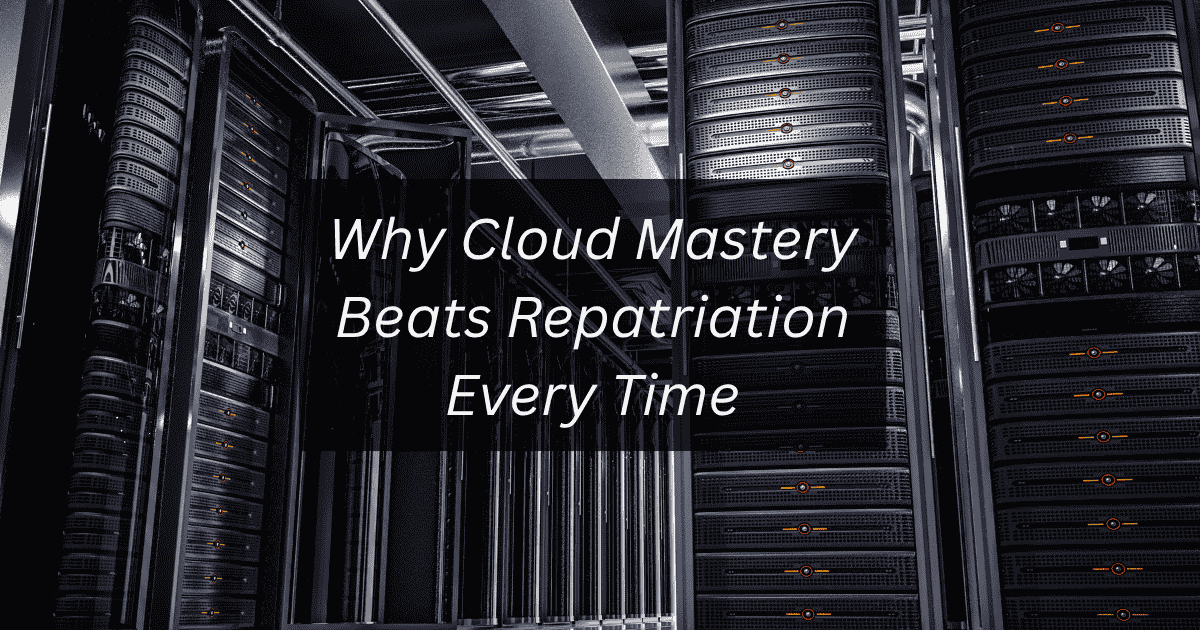The FinOps Architecture Imperative: Building for Cost Prevention, Not Detection

Executive Summary
Strategic Foundation Over Tactical Fixes: Sustainable cloud financial management requires embedding cost controls into your architectural foundation rather than relying on continuous optimization efforts after deployment.
Landing Zone as Financial Control Center: Your cloud foundation serves as the primary mechanism for cost governance. Strategic decisions around organizational structure and connectivity patterns establish spending behaviors that persist throughout your cloud journey.
Essential Governance Elements: Comprehensive resource tagging, deliberate account segmentation, and financially-conscious network architecture form the cornerstone of effective cost containment and organizational accountability.
Next-Generation Workload Considerations: Serverless computing and artificial intelligence applications demand heightened attention to preventive cost controls, as architectural missteps can trigger rapid, exponential spending escalation.
Development Integration: The most effective prevention strategy embeds automated cost impact analysis within development workflows, providing immediate financial feedback before infrastructure changes reach production.Proactive vs. Reactive: True financial control comes from proactively preventing cloud waste through architectural design, not just reactively optimizing it after the fact.
Content Overview
- The Limitation of Reactive Cost Management
- Foundational Architecture for Cost Control
- Advanced Prevention Strategies for Contemporary Technologies
- From Reactive to Proactive: A New Paradigm
- Your Path Forward
Introduction: The Limitation of Reactive Cost Management
A familiar pattern:
The cloud financial team achieves a significant victory by optimizing virtual machine configurations, delivering $50,000 in monthly savings. The achievement generates enthusiasm and recognition across the organization. However, within two weeks, leadership receives concerning news—instead of decreasing, the monthly cloud expenditure has increased by $100,000.
The explanation? During the optimization celebration, a machine learning initiative launched computational services that generated excessive costs through unoptimized logging practices and inter-regional data movement charges. The initial success proved temporary and misleading.
This situation represents the standard experience for most enterprises. Organizations find themselves trapped in an exhausting cycle of cost containment activities, characterized by constant monitoring alerts, strained conversations between technical and financial teams, and the persistent sensation of lagging behind spending trends. Rather than controlling expenses, teams perform forensic analysis on costs already incurred.
"According to the 2025 State of FinOps Report, FinOps teams are moving beyond reactive cost-cutting and shifting toward proactive governance models that help maintain efficiency at scale."
This reactive pattern persists because it addresses consequences rather than root causes. The fundamental issue lies in infrastructure designed, whether intentionally or not, to generate financial inefficiency. Traditional cost management approaches—identifying oversized instances or orphaned storage—apply tactical solutions to strategic problems.
Genuine, sustainable financial control transcends waste identification. It requires strategic prevention of waste generation from the outset. This content provides your roadmap for achieving that transformation, moving from reactive cost management to proactive cost prevention through foundational design choices that shape cloud spending patterns before any resources become operational.
Understanding the Distinction: Management vs. Prevention
These approaches represent fundamentally different philosophies, and conflating them explains why many financial operations programs feel ineffective.
Cost Management (Reactive): The established practice of identifying and eliminating inefficiencies after they occur. Examples include instance rightsizing, removing unused storage, or purchasing commitment discounts. While necessary, this remains a remediation activity.
Cost Prevention (Proactive): Creating structural barriers that make inefficiency creation difficult or impossible. This involves deliberate cloud environment design with cost as a fundamental architectural consideration, equal in importance to security and performance requirements.
Depending exclusively on reactive management resembles maintaining a clean kitchen floor while a sink continues overflowing. Exceptional mopping skills cannot achieve lasting cleanliness without addressing the water source. Cost prevention addresses the source.
The Hidden Costs of Reactive Approaches
Innovation Velocity Tax: Every hour your most skilled (and expensive) engineering talent spends analyzing cost anomalies represents lost opportunity for product development. Using precision tools for work that should be automated directly taxes your innovation capacity.
Experimentation Inhibition Tax: When reactive cost reduction serves as your primary tool, developers become reluctant to explore new technologies. The fear of triggering cost alerts and subsequent difficult conversations creates a risk-averse culture that undermines the agility cloud computing was designed to enable.
Attribution Complexity: Without solid architectural foundations, cost attribution becomes nearly impossible. Expenses accumulate in undifferentiated pools, preventing answers to essential business questions such as "What does serving Customer X cost?" or "Does Feature Y generate profit?" This creates operational blindness.
Foundational Architecture for Cost Control
Central Concept: Your Foundation as Primary Financial Tool
We must reconceptualize the cloud foundation's role. Frameworks like the AWS Well-Architected Framework are frequently viewed merely as security and governance templates. This perspective represents a critical oversight. Your cloud foundation functions as the central control system for your entire financial management infrastructure.
Every foundational decision—from organizational structures to network design—directly and cumulatively impacts your costs. Proper foundation design creates an environment where cost-effectiveness becomes the natural path. Poor design guarantees continued reactive management cycles.
Foundation 1: Strategic Account Architecture for Cost Isolation
Your cloud environment structure—utilizing AWS Organizations and OUs or Azure Management Groups and Subscriptions—establishes the foundation for financial control. A flat architecture where multiple teams deploy resources into shared production accounts creates attribution impossibility. Determining responsibility becomes unfeasible.
Effective architecture mirrors your business structure. Create separate accounts or subscriptions for different environments (Production, Development), business units (Marketing, Research), or major products. This provides immediate cost isolation and clear visibility into Research spending, allowing targeted controls for experimental environments without impacting production systems.
Account Structure Comparison
❌ Poorly Structured (Attribution Challenges)
Azure Tenant Root
└── Management Group
└── Single Production Subscription
├── Marketing Resource Groups
├── R&D Resource Groups
├── Finance Resource Groups
├── Sandbox Resource Groups
├── Dev/Test Resource Groups
├── Production Resource Groups
├── Analytics Resource Groups
└── AI/ML Resource GroupsIssues:
- Difficult team cost isolation
- Limited accountability boundaries
- Mixed development/production resources
- Complex ROI tracking
✅ Well-Structured (Business-Aligned)
Azure Tenant Root
└── Management Group
├── Marketing Management Group
│ ├── Dev Subscription
│ └── Prod Subscription
├── R&D Management Group
│ ├── Sandbox Subscription
│ └── Prod Subscription
└── Finance Management Group
├── Analytics Subscription
└── Prod SubscriptionBenefits:
- Clear business unit cost isolation
- Defined team accountability boundaries
- Environment separation (Dev/Prod)
- Simplified ROI tracking per unit
- Targeted governance policies
Common Example: A company struggles with unpredictable cloud costs when a developer accidentally provisions a $10,000/month GPU instance. The typical solution involves reactive measures—dashboards and alerts reporting on already-incurred expenses.
The superior solution is architectural. Providing each development team with sandboxed environments governed by policies restricting them to cost-effective instances makes expensive mistakes impossible. The problem gets engineered out rather than reported on.
Foundation 2: Mandatory Tagging for Cost Attribution
Direct statement: a "tag later" approach equals a "never tag" reality. Hope does not constitute strategy. Tagging must be mandatory, automated, and enforced at resource creation.
A comprehensive tagging strategy (CostCenter, Project, Owner) creates detailed datasets enabling precise cost analysis. This transforms total bill awareness into specific microservice costs for particular customers.
The implementation mechanism involves native policy engines. Use Azure Policy or AWS Service Control Policies (SCPs) to create rules preventing untagged resource creation. This represents a hard constraint, not a suggestion.
json
{
"mode": "Indexed",
"policyRule": {
"if": {
"anyOf": [
{
"field": "tags['CostCenter']",
"exists": "false"
},
{
"field": "tags['Owner']",
"exists": "false"
}
]
},
"then": {
"effect": "deny"
}
},
"parameters": {}
}Foundation 3: Cost-Conscious Network Design
Network expenses represent the hidden budget killers. Engineers focused on compute and storage often overlook data movement costs. Poor network design can quietly drain resources.
Critical areas for cost prevention architecture:
Data Egress: Data exiting cloud provider networks typically incurs significant charges. Design applications to minimize this traffic. For hybrid applications, strategically position components to reduce expensive Direct Connect or ExpressRoute link usage.
Private Endpoints vs. NAT Gateways: NAT Gateways for private subnet outbound internet access represent common patterns with hourly and data processing fees. When accessing cloud services (S3, Azure SQL), Private Endpoints maintain traffic on the provider's more economical and secure backbone network.
Regional & Availability Zone Strategy: Data transfer costs vary significantly by provider:
- AWS: $0.01/GB between AZs, $0.09/GB for internet egress; Azure: Eliminated AZ transfer fees in 2024, but internet egress ranges from $0.05-0.12/GB depending on volume; Google Cloud: $0.01/GB between zones, with sustained use discounts for egress
For a high-throughput application processing 10TB/month between services, poor placement could cost $1,000+ monthly in transfer fees alone - costs that can be significantly reduced with proper architectural design.
Advanced Prevention Strategies for Contemporary Technologies

These foundational principles apply to cutting-edge technologies, but with elevated stakes. Here, architectural errors don't just leak money; they create financial disasters.
Controlling Serverless Cost Escalation
Serverless architectures embody the pay-for-usage ideal. However, their elasticity creates risks. Poor design can trigger catastrophic cost escalation within minutes.
The industry knows the horror stories. Simple misconfigurations—Lambda functions writing to S3 buckets that trigger the same Lambda—create infinite recursive loops. Before alerting systems activate, functions execute millions of times, transforming theoretically economical architectures into five-figure disasters.
Serverless cost prevention architecture requires built-in safety mechanisms:
Concurrency Limits: Establish financial blast radius caps by limiting simultaneous function instance execution.
Circuit Breakers: Implement patterns detecting abnormal behavior (unusual execution times) that temporarily halt functions to prevent escalation.
Comprehensive Alarming: Extend beyond basic execution counts. Set alarms on metrics like duration and invocation frequency to detect anomalous spikes before they impact financial reports.
AI Workload Cost Prevention
Artificial intelligence and machine learning introduce new cost anxiety categories. Expensive GPU instances and massive data processing amplify small architectural mistakes into budget-devastating overruns. Preventing AI cost shocks requires designing MLOps pipelines with cost as a primary consideration.
Data Gravity Management: Model training requires enormous datasets. Data movement from storage to compute can generate staggering costs. Design solutions using cost-effective storage (Azure Data Lake) in the same region as training compute to avoid egress charges.
Spot Instance Utilization: Not all training requires expensive on-demand GPUs. Design MLOps workflows leveraging spot instances, offering significant discounts for interruption-tolerant workloads—ideal for most training jobs. Spot instances offer up to 90% savings, though actual discounts vary based on demand and availability
Scale-to-Zero Architecture: The most expensive GPU is an idle one. Implement automated lifecycle management for training and inference endpoints. Internal-facing models don't require 24/7 operation. Design them to scale to zero during inactivity.
Practical Example: A media company architected their MLOps pipeline on Azure with cost prevention at its core. They use Azure Data Lake for storing raw video data. A trigger on new data initiates a preprocessing job on a standard compute cluster. The processed data then triggers a training job on a low-priority Azure Machine Learning compute cluster, which is configured to use spot-priced GPU instances. Once the model is trained, it's deployed to an Azure Container Instance with a serverless profile that scales down to zero when there are no requests. This "scale-to-zero" architecture prevents idle, high-cost GPU instances from running 24/7, saving them tens of thousands per month.
Development Workflow Integration: Cost-Aware Code Changes
The ultimate prevention form catches expensive designs before cloud deployment. This means "shifting left" by building cost awareness directly into CI/CD pipelines.
Rather than analyzing costs post-deployment, provide developers workflow feedback. Imagine a developer submitting a pull request with infrastructure-as-code changes. An automated tool immediately analyzes it and comments: "Notice: Merging this change adds a Cosmos DB instance projected at $1,500/month. Confirm intention?" Suddenly, cost becomes tangible and immediate in the development process.
Tools like Infracost or Terracost integrate directly into GitHub or Azure DevOps pull requests. They parse infrastructure-as-code files, query cloud provider pricing APIs, and provide clear cost breakdowns of proposed changes before merging and deployment.
A New Paradigm: Stop Mopping, Start Architecting

The continuous, frustrating cycle of chasing cloud costs represents a choice, not inevitability. By establishing cost as a primary architectural concern, you can fundamentally transform your organization's cloud financial relationship. The solution involves stopping the remediation cycle and finally addressing the source.
Your new financial control mechanisms exist in your architecture, not spreadsheets:
Transform from reactive optimization to proactive prevention. Focus your best engineers on building financial guardrails rather than writing budget overrun post-mortems.
Position your Landing Zone as your primary FinOps tool. The foundational decisions made here have greater financial impact than any optimization script.
Master the foundational elements: Isolate costs with strategic account structures, mandate tagging for perfect attribution, and design cost-aware networks to eliminate hidden charges.
Apply these principles to modern workloads like AI and Serverless, where poor design creates the largest financial blast radius.
Your Initial Step
Transitioning from reactive to proactive models requires a journey beginning with assessment: foundation evaluation. You cannot address inefficiencies without identifying their locations.
To support your start, Crux Cloud Solutions provides a complimentary Landing Zone Health Check. We help identify foundational gaps secretly driving cloud costs upward. It's time to build clouds optimized by design rather than frantic post-deployment cleanup.
Unlock Your Cloud Savings
Ready to stop chasing costs and start preventing them? The strategies in this article are just the beginning. Contact Crux Cloud Solutions for a complimentary Landing Zone Health Check and let our experts architect your cloud for permanent savings.



